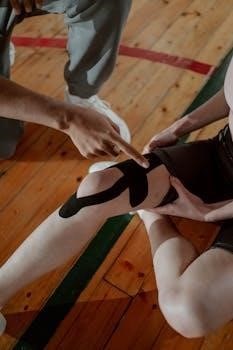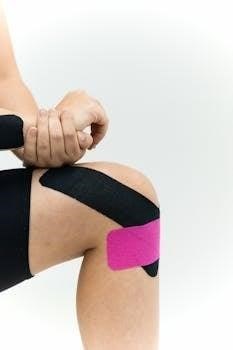
Kinesiology tape, often called KT Tape, offers a unique approach to knee support by gently influencing tissues. It applies a mild pulling force on the skin, affecting the muscles and relieving pressure on the kneecap, this helps to balance the muscles of the knee.
What is KT Tape and How Does it Work?
KT Tape, or kinesiology tape, is a specialized elastic athletic tape designed to support muscles and joints. Unlike traditional rigid athletic tape, KT Tape is flexible, allowing a full range of motion. Its unique design works by lifting the skin microscopically, which may improve circulation and reduce pressure on underlying tissues. This lifting action can also help to decrease pain and swelling, while providing support to injured areas without restricting movement. The application of KT tape exerts a mild pulling force on the skin, thereby influencing the tissues and processes beneath the surface. It can assist in providing a lift to the skin allowing freer movement of fluid under the tape. It’s widely used by athletes and individuals seeking relief from various musculoskeletal conditions. KT Tape is designed to provide knee stability for optimal performance, and assists in relieving pressure, providing stability, and improving muscle function in the knee.

KT Tape Application Techniques for Knees
Applying KT Tape to the knee involves specific techniques to ensure effectiveness. These methods are designed to provide support, stability, and pain relief, addressing a variety of knee-related issues. Proper application is key.
General Principles of KT Tape Application on the Knee
Before applying KT Tape to the knee, ensure the skin is clean, dry, and free from lotions or oils, as these can affect adhesion. When applying over a joint, the knee should be bent to prevent the tape from pulling off during movement. Never stretch the first or last two inches of the tape and make sure to activate the adhesive with a firm rub after application. Proper tension is crucial; generally, apply the tape with about 30-40% tension, avoiding any stretch on the ends. The tape should lift the skin to allow freer fluid movement underneath. Using a two full 25 cm strips is standard, and sometimes an anchor strip may be needed. Correct application is essential for the tape to be effective in reducing pressure and pain.
Step-by-Step Instructions for Basic Knee Support
To begin, sit with your knee bent at a 90-degree angle. Take a full strip of KT Tape and tear the backing paper in the center. Then, roll the backing towards each end leaving about two inches attached. Apply the center of the tape with zero tension to the side of the knee, just below the kneecap. Next, apply the tape around the kneecap and gently bring the ends together without any stretch, ensuring the knee remains bent. For the second strip, follow the same process, placing the center of the tape on the other side of the knee and wrap it around the kneecap. Finally, rub the tape to activate the adhesive.

Specific KT Tape Applications for Common Knee Issues
KT Tape can be applied in various ways to address specific knee problems. For runner’s knee, or patellofemoral pain syndrome, taping techniques focus on reducing discomfort around the kneecap. This often involves using a Y-strip of tape, with the base placed on the thigh and the split ends gently supporting the patella. For IT band pain at the knee, a strip of tape is applied along the IT band, starting from the lateral side of the knee and extending upwards. Additionally, for LCL injuries, taping can provide support by applying tape along the lateral collateral ligament, this helps to alleviate the pain. It is important to note that for all applications the knee should remain bent during application.
Runner’s Knee (Patellofemoral Pain Syndrome)
Runner’s knee, or patellofemoral pain syndrome, is a common ailment causing pain around the kneecap. KT Tape can assist by improving circulation, supporting muscles, and helping to reduce pain. The application for this condition typically involves a Y-strip, with the base placed on the thigh. The split ends are then gently applied around the edges of the kneecap, providing support and alleviating pressure. The knee should be bent during application. Kinesio pre-cut knee support is designed for runners knee, providing support and reducing discomfort. The application comes with I-strips and a Y-strip. Remember to apply the tape without stretching the first or last two inches and always rub the tape to activate the adhesive.
IT Band Pain at the Knee
IT band pain at the knee is a condition that KT Tape can help manage by relieving pressure and providing stability. This application often involves applying a strip of KT Tape along the side of the thigh, extending down towards the knee. The key is to apply the tape with a slight stretch, carefully following the line of the IT band, ensuring the knee is in a bent position during application. The tape helps to lift the skin, potentially improving fluid movement beneath the surface, which may reduce discomfort associated with IT band issues. This technique could be used for other similar conditions, providing needed support to the area. Remember, never stretch the first or last two inches of the tape.
LCL Injury Taping
Taping for an LCL injury at the knee can be beneficial in managing symptoms. This involves applying kinesiology tape to provide support and reduce stress on the lateral collateral ligament. Start by ensuring the knee is slightly bent, then apply the tape along the outside of the knee, following the path of the LCL. The tape should be applied with a slight tension to help stabilize the joint. This technique may help to alleviate some symptoms experienced by athletes. Remember to avoid stretching the initial and final two inches of the tape. Proper application may assist in reducing discomfort and promoting healing in the affected area and improve range of motion.

Important Considerations for Effective KT Tape Use
To maximize the benefits of KT Tape, it’s crucial to avoid common mistakes like applying tape with too much tension or on unclean skin. Correct application techniques will ensure the tape stays in place and provides the intended support.
Common Mistakes and How to Avoid Them
One frequent error is applying KT Tape to a dirty or oily skin surface, which prevents proper adhesion. Always clean the skin thoroughly and ensure it is dry before application. Another mistake is stretching the tape too much during application, especially at the ends. The initial and final two inches should be applied with zero tension to avoid skin irritation and premature peeling. Moreover, applying tape over a fully extended knee can lead to the tape pulling off as you bend. Ensure the knee is in a slightly bent position during the taping process. Failure to rub the tape vigorously after application can prevent the adhesive from properly activating. Remember to firmly rub the tape to secure it. Lastly, not following the specific step-by-step instructions for the knee area will render it ineffective. If you are unsure how to apply tape, seek professional medical help.

When to Seek Professional Medical Advice
While KT Tape can provide relief and support for various knee conditions, it is not a substitute for professional medical care. If you experience severe pain, swelling, or limited range of motion in your knee, it’s crucial to consult a healthcare professional. If you have an injury that affects functional mobility, you should seek professional advice. If your knee pain persists despite using KT Tape, or if it worsens, it may indicate an underlying issue that requires medical attention. Similarly, if you suspect a tear, rupture, or inflammation of the meniscus, it is essential to consult with a doctor. Conditions like arthritis can also reduce a person’s range of motion, and it’s important to consult a doctor for proper diagnosis and treatment. Remember, KT Tape can be a great tool, but it is not a cure for all knee problems, and professional guidance is sometimes necessary to determine the best course of action.